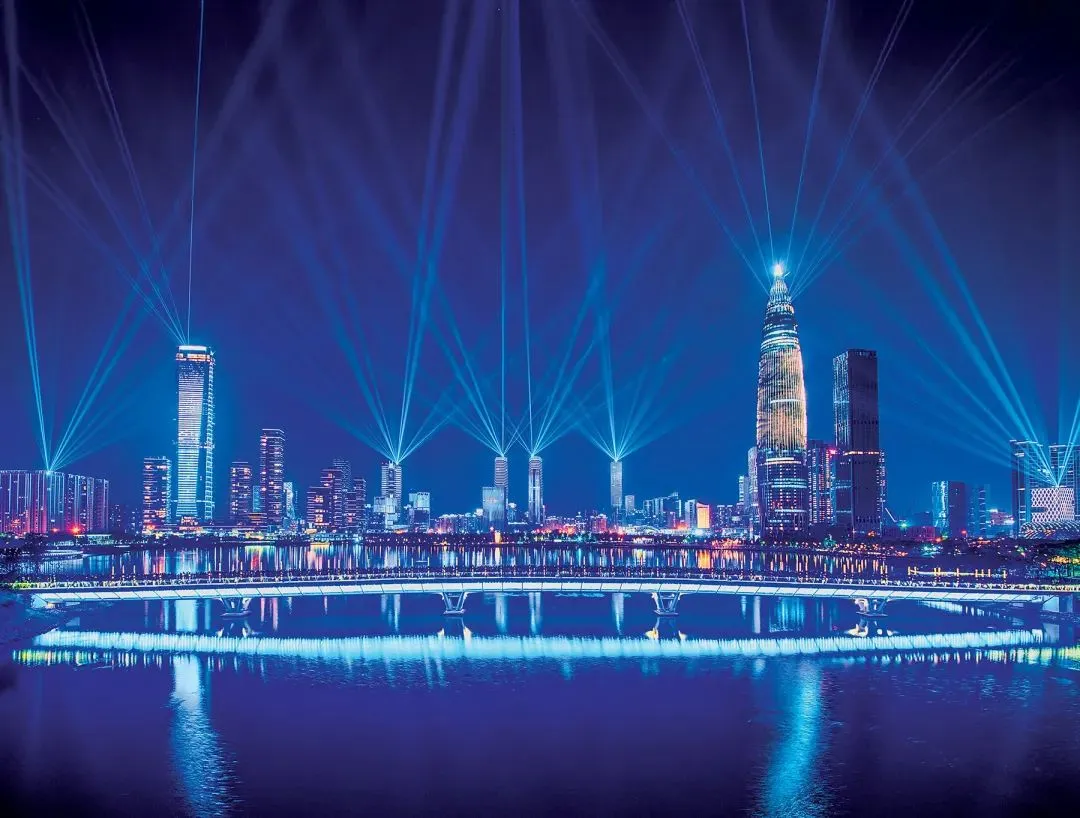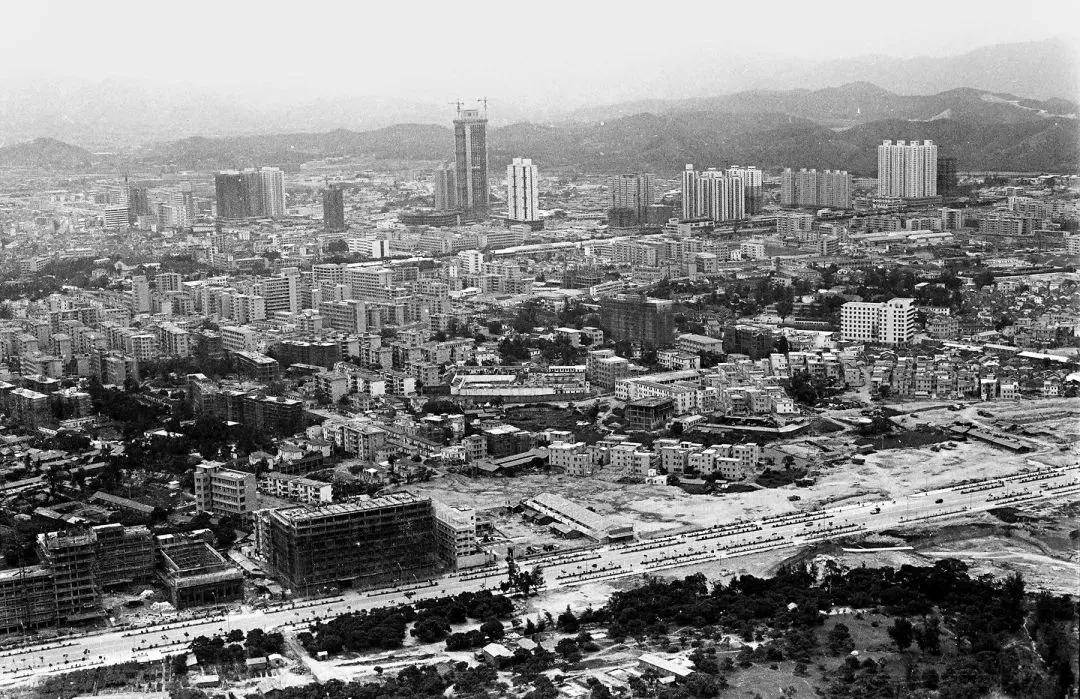- +1
雙語深圳 | Pioneer city comes of age 先鋒之城,風華正茂

//The glittering nightscape of Shenzhen’s Nanshan district. (PROVIDED TO CHINA DAILY)
Walking along the 25-kilometer-long Shennan Boulevard — one of Shenzhen’s major arterial thoroughfares — takes Wang Guofu down memory lane. With the cityscape unfolding before him, he reminisces about its remarkable transformation, recalling how his fate has been intertwined with the metropolis in its 45-year-long history as one of China’s pioneering special economic zones (SEZs).
行駛在全長25.6公里的深南大道上,王國富的思緒不禁飄回過去。眼前不斷鋪展的城市風貌,讓他回憶起深圳45年來的驚人蛻變,也想起自己的命運如何與這座中國經濟特區的發展緊密交織。
The 58-year-old factory worker left his hometown in Shangrao — a city in eastern Jiangxi province — in search of greener pastures in Shenzhen in 1992 following in the footsteps of an adventurous friend.
1992年,這位58歲的工廠工人在朋友的介紹之下離開江西上饒,來到深圳尋找更好的發展機會。
“I knew next to nothing about Shenzhen at the time,” says Wang. “All I knew was that it’s near Hong Kong and that, as my friend put it, Shenzhen was a place to seek a fortune.”
“那時候我對深圳幾乎一無所知,” 王國富說。“只知道它離香港近,并且是個能‘淘金’的地方。”
After setting foot in the southern town in Guangdong province, he realized it was far more than that. “In Shenzhen, everyone worked with energy and drive. It was like they were building their homes,” he says.
但踏上這片廣東南部的土地后,他發現這里遠不止于此:“在深圳,每個人工作都充滿干勁,就像在建設自己的家一樣。”
Shenzhen’s inherent spirit of entrepreneurship and inclusiveness emboldened Wang’s resolve to bring his family and settle down there. Today, his daughter works at a financial technology firm in the city. “I’m fortunate that my family has been able to grow up together with Shenzhen,” he says.
深圳與生俱來的創業精神與包容氛圍,讓王國富下定決心接來家人、在此定居。如今,他的女兒在深圳一家金融科技公司工作。“很幸運,我的家人能和深圳一起成長。”
Wang’s story is woven into the tapestry of tens of thousands of workers who have contributed to Shenzhen’s early development as one of the country’s first four SEZs, and whose second generation has moved on to sink their roots into the city, continuing to contribute to its growth.
王國富的故事,是無數勞動者共同經歷的縮影。作為中國首批四個經濟特區之一,深圳早期發展離不開數以萬計勞動者的付出;如今,他們的下一代在此扎根,繼續為城市發展貢獻力量。
The vast opportunities Shenzhen has created for generations of Chinese residents mirror the boomtown’s dramatic industrial evolution and shiftingentity over time. In the 1980s and early 1990s, manufacturing, construction and trade were the lifeblood of Shenzhen’s economy. Leveraging its proximity to Hong Kong, along with low land and labor costs, Shenzhen thrived on processing trade — a model that propelled rapid growth, but left it lingering at the lower end of the global value chain, with local workers reaping only a small share of the gains.
深圳為一代又一代中國人創造的廣闊機遇,也映射出這座“機遇之城” 產業的劇烈變革與城市定位的迭代升級。20世紀80年代至90年代初,制造業、建筑業和貿易是深圳經濟的支柱。憑借毗鄰香港的區位優勢,以及低廉的土地和勞動力成本,深圳通過加工貿易實現快速發展 —— 但這種模式也讓深圳長期處于全球價值鏈低端,本地勞動者的收益十分有限。
According to official statistics, the value of processing trade in Shenzhen accounted for roughly 72 percent of the city’s total export value and 76 percent of total import value in 1990. The number of processing trade-related enterprises surged to almost 8,000 in 1994, with some 1 million people employed in the sector, including Wang.
根據官方統計數據,1990年深圳加工貿易額占全市出口總額的比重約為72%,占全市進口總額的比重約為76%。1994年,加工貿易相關企業增至近8000家,該領域就業人數約100萬。王國富便是其中之一。
Today, the land of opportunity has grown hand in hand with Shenzhen’s meteoric rise as a hub for finance, technology and innovation. It is home to over 25,000 national-level high-tech enterprises, including tech giants Huawei, Tencent and DJI. The number of international patent applications made through the Patent Cooperation Treaty in Shenzhen has topped Chinese mainland cities for 21 consecutive years.
如今,隨著深圳躍升為金融、科技與創新中心,這片“機遇之地” 也隨之不斷發展。目前,深圳擁有超過2.5萬家國家級高新技術企業,包括華為、騰訊、大疆等科技巨頭;PCT國際專利申請量連續21年居全國首位。
The transformation reflects a broader trend in Shenzhen, where emphasis has shifted from labor-intensive industries to knowledge-driven sectors. The evolution has also redefined the SEZ’sentity, shifting it from the “world’s factory” to a “cradle of innovation”.
這種轉變印證了深圳發展的大趨勢——城市重心從勞動密集型產業轉向知識驅動型產業。這一演進也重塑了經濟特區的定位—— 從 “世界工廠” 蛻變為 “創新搖籃”。
Like many other people of her age, the younger Wang found her footing in the new ecosystem. “The older generation was chasing fortune. We, the younger generation, are chasing something bigger — changing the way people live, just like Shenzhen has changed ours,” she says.
和許多同齡人一樣,王國富的女兒在新的產業生態中找到了自己的位置。“父輩們當年是為了‘淘金’,我們這一代則在追求更有意義的事 —— 改變人們的生活方式,就像深圳改變了我們的生活一樣。”

//The contrasting views of Shenzhen’s Luohu district in 1985 and in the present day illustrate the city’s profound transformation. (LIU TINGFANG AND LUO XUAN / FOR CHINA DAILY)
City of opportunities
機會之城
Shi Kun, director of the department of regional development and planning at Shenzhen-based think tank the China Development Institute, says, “When it comes to Shenzhen providing development opportunities for workers of different eras, the greatest chance lies in industrial opportunities. In other words, workers who come to Shenzhen can find jobs and earn money — this is the most fundamental aspect, which requires the development of industries that keep pace with the times.
綜合開發研究院(中國·深圳)區域發展規劃所所長時鯤表示,深圳為不同時代的勞動者所提供的最大機遇在于產業機遇。“來深圳的人能找到工作、賺到錢,這是最根本的,而這需要與時俱進的產業發展作為支撐。”
“Beyond this, Shenzhen now also places great emphasis on supporting facilities, particularly comprehensive cultural, educational and healthcare support for knowledge-intensive talents,” he adds.
“除此之外,深圳現在也非常重視配套設施建設,尤其是為知識密集型人才提供全方位的文化、教育和醫療保障。”
There is also a fundamental urban culture in the city that underpins the provision of opportunities for workers, according to Shi. “Shenzhen has a well-known saying: ‘Once you come, you are a Shenzhen local.’ This saying actually embodies the positive cycle of mutual success between the city and individuals,” he says.
Since Shenzhen’s birth as an SEZ in 1980, its name has been synonymous with “economic miracle”, with its GDP having skyrocketed from 270 million yuan ($37.58 million) in 1980 to 3.68 trillion yuan last year, roughly equivalent to the economic size of the United Arab Emirates.
支撐深圳為勞動者提供機遇的,還有其獨特的城市文化根基。“深圳有句廣為人知的話:‘來了就是深圳人’。這句話其實體現了城市與個人相互成就的良性循環,”他補充道。 自1980年成為經濟特區以來,“深圳” 一詞數十年來始終與 “經濟奇跡” 緊密相連:1980年,深圳地區生產總值(GDP)僅 2.7億元。去年,這一數字已攀升至3.68萬億元。
Behind Shenzhen’s economic boom lies its bold drive for institutional innovation. As a trailblazer of China’s reform and opening-up, the city has blazed an unprecedented path — one that offers a replicable template for the rest of the nation.
深圳經濟騰飛的背后,是其大膽推進制度創新的決心。作為中國改革開放的“試驗田”,深圳走出了一條前所未有的發展道路,為全國提供了可復制、可推廣的經驗。
Shenzhen’s astonishing shift from a tiny fishing village to a world technology hub in the past four-and-a-half decades testifies to China’s landmark reform and opening-up drive, shaped by domestic imperatives, as well as international opportunities, says Tao Yitao, former director of the China Center for Special Economic Zone Research at Shenzhen University.
深圳大學中國經濟特區研究中心前主任陶一桃表示,過去45年間,深圳從小漁村崛起為全球科技樞紐,這一驚人蛻變印證了中國改革開放的飛速進程 —— 這一進程既受國內發展需求驅動,也得益于國際機遇。
She recalls that the mainland’s economy was still budding in the late 1970s, with a broad consensus for change, and Shenzhen became a testing ground for bold experiments.
她回憶道,20世紀70年代末,中國內地經濟尚處于起步階段,全社會對改革形成廣泛共識,深圳由此成為大膽探索的 “試驗場”。
Internationally, the 1970s saw global industrial transfer, with labor-intensive industries moving from Japan and Germany to the “Four Asian Tigers” — South Korea, Singapore, Hong Kong and Taiwan. Shenzhen, leveraging its geographical proximity to Hong Kong and low labor and land costs, was a prime beneficiary. The establishment of Sino-US diplomatic ties in 1979 created a more favorable international environment for its development, says Tao, who is also dean of the Belt and Road Research Institute (Shenzhen) for International Cooperation and Development.
從國際環境來看,1970年代全球產業轉移浪潮中,勞動密集型產業從日本、德國向韓國、新加坡、中國香港和中國臺灣這 “亞洲四小龍” 轉移。而深圳憑借毗鄰香港的區位優勢,以及低廉的勞動力和土地成本,成為這一浪潮的重要受益者。陶一桃指出,1979年中美建交也為深圳發展創造了更有利的國際環境。
“Although Shenzhen’s economic takeoff began with processing trade, it didn’t end up there. By the 1990s, the local authorities had recognized the limitations of low-end manufacturing and decided to pivot its economy toward high-tech, laying a solid ground for its current tech hub status,” she says.
“盡管深圳的經濟騰飛始于加工貿易,但并未止步于此。到1990年代,地方政府已意識到低端制造業的局限性,決定推動經濟向高新技術產業轉型,為如今的科技樞紐地位奠定了堅實基礎,” 她說。

//The contrasting views of Shenzhen’s Luohu district in 1985 and in the present day illustrate the city’s profound transformation. (LIU TINGFANG AND LUO XUAN / FOR CHINA DAILY)
Creating new miracle
創造新的奇跡
To push Shenzhen toward assuming a greater role in the nation’s pursuit of high-quality development and deeper integration into the world economy, the central government issued a document in June to further deepen comprehensive reform and accelerate opening-up and innovation.The guideline outlined concrete steps to break through institutional barriers in education, technology and talent development, and strengthen the deep integration of innovation, industrial, capital and talent chains.It also serves as an updated version of a directive in 2020 that focused on supporting Shenzhen as a pilot area for implementing comprehensive reform.
為推動深圳在國家高質量發展和深度融入世界經濟中發揮更大作用,今年6月,中共中央辦公廳、國務院辦公廳發布《關于深入推進深圳綜合改革試點深化改革創新擴大開放的意見》,提出在破解教育科技人才領域體制機制障礙、強化創新鏈產業鏈資金鏈人才鏈深度融合等方面先行先試。這也是2020 年所發布的《深圳建設中國特色社會主義先行示范區綜合改革試點實施方案(2020-2025年)》的升級版。
“The latest document has entrusted Shenzhen with new tasks and missions to advance reform, opening-up and innovative development at a higher starting point, on a higher level and with higher goals,” wrote a group of researchers at the China Development Institute.
“最新文件賦予深圳新的任務與使命,推動其在更高起點、更高水平、更高目標上推進改革開放和創新發展。” 綜合開發研究院(中國·深圳)的研究人員在一篇文章中寫道。
However, it has not been smooth sailing against a backdrop of mounting geopolitical tensions, rising protectionism and unilateralism.
然而,在當前地緣政治局勢緊張、保護主義和單邊主義抬頭的背景下,深圳的發展并非一帆風順。
“China-US trade frictions and global economic uncertainties pose serious challenges to Shenzhen’s economy, including mounting trade barriers, supply chain disruptions and tech restrictions. To offset the impact, the city needs to accelerate industrial upgrading, explore emerging markets engaged in the Belt and Road Initiative, and boost research and development to achieve tech self-reliance,” says Tao.
“中美貿易摩擦和全球經濟不確定性給深圳經濟帶來挑戰,包括貿易壁壘加劇、供應鏈中斷、科技限制升級等。” 陶一桃強調,“為抵消這些影響,深圳需加快產業升級,開拓‘一帶一路’沿線新興市場,加大研發投入以實現科技自立自強。”
Shenzhen is pulling out all the stops to develop strategic emerging businesses and future industries as the answer to forging another “economic miracle” in the coming decades amid a volatile global landscape. It has launched policies to develop and bolster 20 strategic emerging sectors and nurture eight industries of the future.
深圳正全力以赴發展戰略性新興產業和未來產業,力求再創經濟輝煌。目前,深圳已出臺政策,培育發展壯大“20+8”產業集群,即發展以先進制造業為主體的20個戰略性新興產業集群,前瞻布局8大未來產業。
The strategic emerging sectors cover telecommunications, semiconductors, intelligent terminals and sensors, software, intelligent robots, precision instruments and equipment, new energy, intelligent connected vehicles, new materials, high-end medical equipment and biomedicine.Future industries will embrace synthetic biology, blockchain, cells and genes, space technology, brain science and brain-like intelligence, and quantum information.“With continued focus on technological innovation, Shenzhen is poised to take the lead in emerging sectors such as artificial intelligence, big data, new energy and biotechnology. Through deeper collaboration with Hong Kong, Shenzhen will work hand in glove with the special administrative region to become a global financial hub,” says Tao.
“只要持續聚焦科技創新,深圳有望在人工智能、大數據、新能源、生物技術等新興領域占據領先地位。通過與香港深化合作,深圳將與香港特別行政區攜手,共同打造全球金融樞紐。” 陶一桃表示。
Shi considers “innovation and globalization” as the two keywords defining Shenzhen’s next 45 years.
時鯤將“創新” 與 “全球化” 視為定義深圳未來 45 年發展的兩大關鍵詞。
“Shenzhen has basically achieved the status where people immediately associate it with sci-tech innovation when the city is mentioned. In the future, it can further strengthen and elevate this advantage to make it more prominent,” he says.
“現在提到深圳,人們基本都會立刻聯想到科技創新。未來,深圳可進一步鞏固并提升這一優勢,讓其更加突出。”
“As for globalization, it represents Shenzhen’s ability to gather global elements such as talent, goods and data. Moving forward, Shenzhen is poised to develop into a globalized international metropolis.”
“至于全球化,這體現了深圳匯聚全球人才、商品、數據等要素的能力。未來,深圳有望發展成為一座高度全球化的國際大都市。”
For the younger Wang, however, what drew her most to work and live in Shenzhen was not just its promising industry outlook but, more importantly, the profound sense of belonging the city fosters.
不過,對王國富的女兒而言,吸引她在深圳工作生活的,不僅是這座城市廣闊的產業前景,更重要的是其所營造的強烈歸屬感。
“Shenzhen isn’t just a place of opportunity. It’s where I call home,” she says.
“深圳不只是一座機遇之城,更是我的家。”(中國日報記者 周沫)
本文為澎湃號作者或機構在澎湃新聞上傳并發布,僅代表該作者或機構觀點,不代表澎湃新聞的觀點或立場,澎湃新聞僅提供信息發布平臺。申請澎湃號請用電腦訪問http://renzheng.thepaper.cn。





- 報料熱線: 021-962866
- 報料郵箱: news@thepaper.cn
互聯網新聞信息服務許可證:31120170006
增值電信業務經營許可證:滬B2-2017116
? 2014-2025 上海東方報業有限公司




